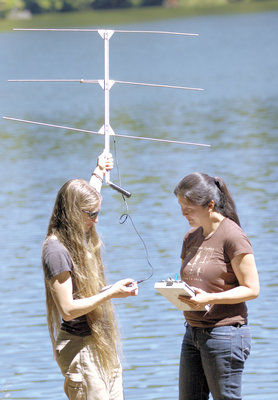
What does it feel like to be alone at night in the woods just a few feet away from a sleeping mountain lion?
“Scary, yet peaceful,” says Yiwei Wang, a graduate student in environmental studies at University of California, Santa Cruz.
She is part of the Santa Cruz Puma Project, a group that finds and collars mountain lions at Loch Lomond Reservoir in the Lompico area. The big cat Wang talks about had been sedated and collared and had awakened but was napping when her project leaders left her alone with it for a while.
Even though she is young, Wang, a native of Santa Clara, is a veteran field researcher. She even studied in Australia, where a bird stole her wedding ring. (She remains ringless.)
Veronica Yovovich, from Chicago, is also a team member and grad student, but her route was more circuitous than Wang’s, taking her to a dinosaur lab and a job in biotech before she realized she wanted to be out in the field helping animals.
They have both spent time setting up cameras, using antennas to get coordinates from the GPS collars, putting roadkill bait in cages and sleeping on the ground. Field studies are marked by long periods of waiting and researching, with sudden spirals of heart-pounding excitement.
The GPS collars signal every six hours, alerting researchers to the pumas’ locations. Chris Wilmers, assistant professor of environmental studies at UCSC and leader of the Puma Project, receives those signals as text messages. While teaching, he will sometimes stop the class, saying, “I’m getting a text from 14F.” Then he will tell his students what the animal’s coordinates are. It’s like the mountain lion is tweeting him, “Want to join me for a latte?”
The field work in Santa Cruz is the first phase of a 10-year research and conservation effort to study and protect the Bay Area puma population, in partnership with the Felidae Conservation Fund and the California Department of Fish and Game.
You can join Yovovich, Wang and me for a nature walk at Loch Lomond on July 17. They will take their equipment, and we might pick up some mountain lion signals.
We will meet up with Chris Berry, water resources manager for the city of Santa Cruz, and chief ranger Scot Lang, too.
Would you like to join Berry for the Father Secchi Dip-In?
No, you do not have to take your swim suit. In 1865, Father Pietro Secchi, scientific adviser to the pope, was the first to use discs to measure the clarity of the water in the Mediterranean. With a few minor changes, scientists are still using the instrument today. We will lower one into Loch Lomond to check the transparency of the water.
Berry and Lang will also show us how to check for turbidity and what that means for the health of the lake. Plus, we will learn about native red-legged frogs and western pond turtle projects and about the effects of non-native species, such as “killer bass” and bullfrogs.
The city of Santa Cruz named the reservoir Loch Lomond after the largest lake (loch) in Scotland, and the recreational areas after the clans that lived there, as an homage to the Scottish settlers of the Santa Cruz Mountains. Officials even flew to Scotland to carry back a cup of water from that lake to christen our Loch Lomond.
Thanks to the good folks at the city of Santa Cruz, you will be able to take your well-behaved, leashed dog with you on our walk. Also, a big thanks goes out to the San Lorenzo Valley Water District for its environmental education grant that makes these free nature walks possible.
Carol Carson is an environmental activist who writes a regular nature column for the Press-Banner. She has been a docent at Henry Cowell Redwoods State Park and taught courses on Big Basin State Park for UCSC Extension. She can be reached at ca****@*********on.com.












